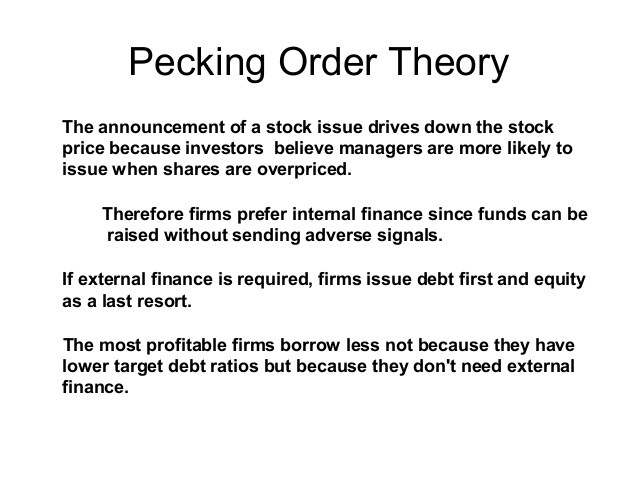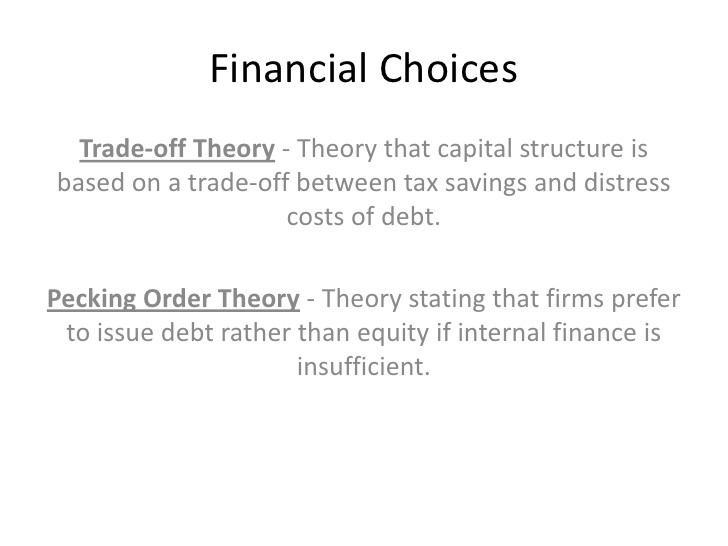Topic 5 Capital structure trade off theory v order theory
Post on: 26 Сентябрь, 2015 No Comment

The capital structure of a firm refers to the mixture of equity and debt that the firm employs to finance itself. The crucial issue in terms of deciding the right capital structure for a firm is to identify the combination of equity and debt that maximizes the market value of a firm; where this is maximized, the company minimizes the cost of its capital.
Modigliani and Miller have famously demonstrated how, under a very specific set of assumptions, the capital structure of the firm does not affect its value. This finding has been subsequently overturned due to the unrealistic nature of its assumptions, such as the absence of taxes, risk, bankruptcy costs, asset characteristics and asymmetric information. Unfortunately such elements have a bearing in the context in which firms operate on a daily basis: for instance, the cost of financing a firm’s debt is tax deductible and bankruptcy has both direct (e.g. litigation) and indirect (e.g. lost business) costs. On these facts rests the first of the two mainstream theories used to conceptualize capital structure, the so-called trade off theory: debt is typically cheaper for a firm to service because it does not imply any form of risk-sharing and it can be collateralized, unlike equity that is a residual claim. In this sense, a firm can lower its weighted average cost of capital, at least initially, through leverage. Leveraging, however, also increases the financial risk of the firm that must service its debt regularly, unlike its equity. In this sense, a firm must balance the benefit brought about by the lower average cost of capital against the increase in financial risk: trade off theory identifies the optimal debt-to-equity ratio as the level at which the two offset each other.
The second theory used to conceptualize capital structure is the so-called Pecking Order Theory, according to which firms prefer to finance themselves internally through retained earnings; when this source of financing is not available, the company issues debt and only in the last instance does it issue equity. This is due to the type of message that the different type of securities send to the market: while debt signals to investors that management are confident that they can service the debt, equity signals that management believe the firm to be overvalued and could potentially trigger a fall in its share price. In this sense, pecking order theory analyses capital structure from a point of view rooted in agency theory, and describes financing decisions as potentially affected by managerial attempt to minimize supervision from shareholders.
Empirical research has found conflicting evidence on the ability of these theories to explain how firms go about their financing decisions; nonetheless, it has substantially improved our understanding of the factors that influence capital structure. Psillaki and Daskalakis (2009), for instance, find evidence consistent with pecking order theory, specifically that leverage tends to be positively correlated with the size of a firm and the portion of its assets that are tangible, whereas it tends to be negatively correlated with its profitability and risk. More profitable firms can finance their capital expenditure internally instead of raising capital externally, as predicted by pecking order theory. The firms surveyed by Psillaki and Daskalakis (2009) all belong in what Bancel and Mittoo (2004) define as a French Law system, and in this sense the findings from the former are consistent with predictions from the latter that differences in the legal system explain differences in capital structure between legal systems. Bancel and Mittoo (2004) find evidence that supports the hypothesis advanced by La Porta et al (1998) that more advanced legal systems provide higher creditor protection, which lowers agency costs and increases the availability of debt capital.
Even though the research described above has provided useful evidence that aids our understanding of capital structure determinants at the micro level, at the macro level the debate on capital structure remains dominated by the trade off theory versus pecking order theory argument. Given the impossibility of resolving this argument, it is interesting to look at attempts to reframe this debate. Agca and Mozumdar (2004), for instance, have argued that the theories should not to be thought of as conflicting but as complementary:
“[the] conflicting nature of the existing evidence on the pecking order theory is due to the difference between financing practices of large and small firms, and the skewness of the firm size distribution. The theory performs poorly for small firms because they have low debt capacities that are quickly exhausted, forcing them to issue equity. The pecking order theory performs satisfactorily for large firms, firms with rated debt, and when the impact of debt capacity is accounted for” (2009).
In this sense, they find that trade off theory considerations help firms determine their debt capacity, while pecking order theory describes firms’ preferences between different methods of financing. Pecking order theory seems to explain satisfactorily the financing behavior of larger firms, but not of smaller firms, that are constrained by their limited borrowing capacity. The explicit distinction that this model makes between smaller and larger firms seems like a sensible addition; a firm’s size is an overriding variable that has important consequences for the extent to which the firm has access to capital markets. Another interesting model on capital structure links it to the firm’s dividend policy (Faulkender, Mulbourn and Thackor, 2006): they argue that the better past performance, the higher is agreement between management and shareholders. This in turns leads shareholders to accept a less favourable capital allocation vis a vis management: they accept a lower dividend payout, which in turn translates in higher cash reserves at the firm and thus a lower leverage ratio. They find empirical support for their hypothesis and argue that it explains why firms like Microsoft did not pay any dividend and did not take on debt for a long period of time: returns to investors are represented by the increases in share prices that accrue thanks to the high level of agreement.
Overall, the debate over capital structure is unlikely to be resolved in terms of predominance of one of the two theories prevailing over the other, if anything because there are a larger amount of elements that have to be factored into the equation than those that appear in the theories outlined above: whilst it is important for a capital structure to minimize the weighted average cost of capital, such considerations have to be balanced against considerations of flexibility, for instance, that are even more important in today’s operating environment. In this sense, the existence of multiple theories on capital structure, as opposed to one, may in fact be beneficial.

References:
ssrn.com/abstract=686865 ;














